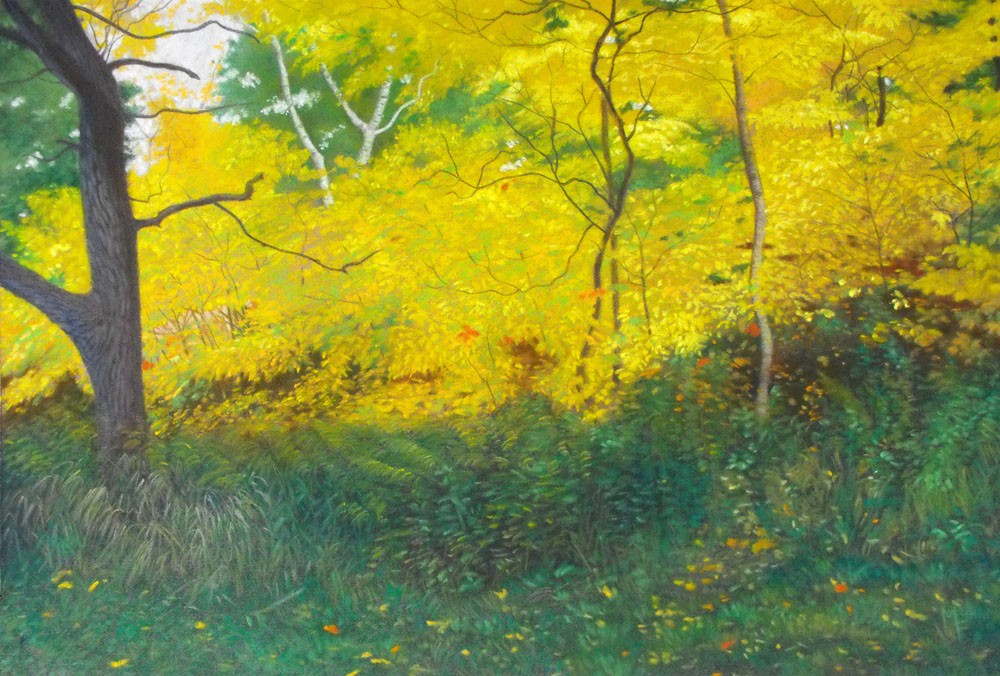
Michelle Farooqi’s landscapes currently on display at Alhamra Art Gallery Lahore offer reality in its most potent, pleasant and pure state

One keeps hearing laments for a forsaken land and longing for a new home. Perhaps as any migrant re-produces his lost homeland with the help of pictures, relics, artefacts and recollections, the human race is also recalling its ideal home by emulating Eden in its surroundings.
But no one has seen Eden, so nobody knows what it looks like except what is stated in the scriptures and is interpreted by the believers. By and large, there exists a consensus about Eden being a perfect garden -- of meadows, streams, vegetation and a permanent spring. The history of human race is about detachment from nature and descending into man-made inhabitations. In a way, animals in the wilderness and jungles still exist in an Eden-like atmosphere, because they are not too detached from their natural existence and instincts.
So man in his world -- made of metal and concrete -- yearns for lost pastures and recreates them by adding a garden in his house, designing parks in urban neighbourhoods and occasionally travelling to areas that are not contaminated with materialistic progress.
Sometimes he is not obliged to move physically, as he can bring images of Eden into his world. You can not miss posters of green fields, trees, flowing springs and beautiful flowers pasted on the walls of small adobes or one room apartments. Likewise, in large houses where weather hardly interferes (because of temperature controlled by air conditioning in summer and heating in winter), one encounters landscape paintings of all regions and seasons. The urge to display these paintings can be a way to reconnect with an abandoned past/place -- either one’s rural background, or human kind’s primal/initial home.
Thus, landscape painting has remained a popular art form in various cultures, a blessing for its practitioners because it is not viewed in its formal and pictorial context but often with a romantic fervour. This aspect presents a problem for painters, but there have been examples of artists (the French Impressionists, and Khalid Iqbal in our context) who have focused on the essence of nature and portrayed it by concentrating on multiple ideas -- ranging from light, colour, and time to atmosphere -- or combing them all.
In the works of Michelle Farooqi, one finds a similar approach towards nature. Her landscapes in her solo exhibition ‘A Walk in the Park’ (being held from Feb 1-5, 2016 at Alhamra Art Gallery, Lahore) reveal the artist’s keen eye in recording details and capturing the atmosphere in different seasons and locations. Some works were made in Canada (Michelle Farooqi has studied at the Ontario College of Art and Design University and Academy of Realist Art in Toronto) while others are about Lahore which is her present place of residence.
Looking at her work, and knowing the origins of spots which are rendered in pastels on paper, one realises how the work of an artist differs from that of a photographer -- an artist does not document what is out there, but amends, alters and edits in order to produce and present his/her personal view and vision. For instance, in Farooqi’s work, one notices a particular peacefulness while she depicts passages and lanes in gardens (from Lahore or Toronto); and the repose apparent in these paintings can not be separated from the personality of the painter that conveys a sense of serenity and calmness.
A similar feeling is evoked in her chosen images, regardless of whether these have humans or a strolling cat. Rows of plants, paths in parks, lone trees, a single bench, foliage blossoming in red and yellow, and ripples of water are a few favourite motifs in her work.
Apart from these landscapes, Michelle Farooqi has painted portraits and still-lifes too (not being shown in her present exhibition), which have the incredible quality to surprise a viewer because of the ‘presence’ of her subject matter. In one canvas, if you look at oranges in a crystal bowl, you cease to see a painted surface but start to feel the sensation of glass surface and the texture of outer skin and the weight of fruit transmitted to your hand.
This ability to convert pigment, oil and fabric into a physical experience is no mean achievement. You need inborn talent and you could polish it through education. For an untrained eye, this is a feat of magic but for a professional painter it demands years of observation, familiarity with material and practice in order to achieve this.
Yet some artists, even after a long period of labour of love, are unable to attain that quality, only because the skill or craft can not ensure the pleasure of painting. It is something beyond this (one could term it as the spirit of painting) that enables a work to live longer in the minds of audience. By using the medium of pastel, Farooqi offers reality in its most potent, pleasant and pure state. On surface, these are views of parks and nature but, gazing at each composition, one identifies with the trees, leaves, passages, waterways, animals, benches and other elements, as every component of her compositions seems to be breathing and alive.
The game of recognising human bondage is at its highest when you look at ‘Evening Crows’, a small pastel with birds that seem to be in conversation. The artist not only focuses on these never-resting creatures but her work can be read like a simile of this nation’s favourite pastime -- talk and more talk. Even if the painter did not aim for this interpretation, art like nature can be viewed, re-viewed and read in more ways than one -- with each encounter being a new, authentic and exciting one.